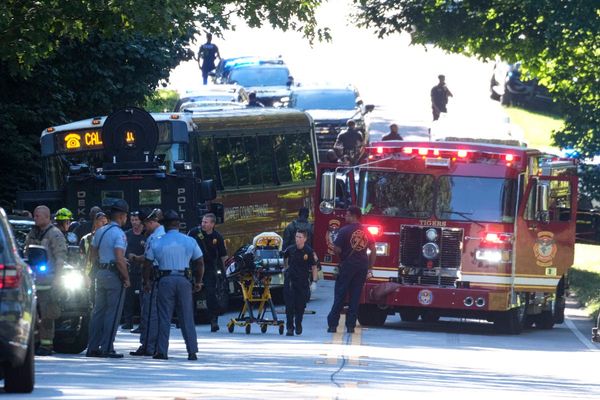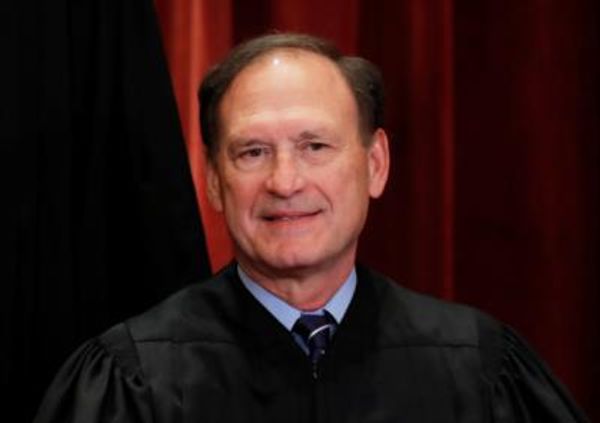There was a time in the United States when abortion wasn't so political, but one conservative Christian man believed it could be.
To him, the reproductive rights of women presented an opportunity. He dreamed of building a coalition — a powerful voting bloc that would help pull the Republican Party to the right.
He needed an issue that would bring conservative Americans of Christian faiths together, something they could sell as a family value and that positioned the coalition as morally superior.
Abortion could prove potent.
And so, the conservative political strategist set about testing the theory, even proclaiming that when the "moral majority" had power, they would be able to "re-shape the nation".
His name was Paul Weyrich and he warned the people in his movement were "radicals".
Weyrich was planting these seeds in the 1970s and while he was playing a very long game, it seems his vision is now coming to pass.
The so-called 'religious right' is now a large-scale political and social movement made up of Americans whose identity is defined by the fusing of their conservative faith and their politics.
It was the issue of abortion that rallied and fuelled this movement and now, as some analysts suggest, the rise of the so-called religious right has likely exceeded even the most ambitious expectations of its founders.
The conservative Christian coalition Weyrich sought to build not only exists, but wields an immense power over the Republican Party as well as the political and judicial systems designed to protect the freedoms of all Americans — no matter their faith.
The rise of the religious right
To understand the origins of the American political movement known as the religious right, those who have long studied it suggest first asking why it began.
In the 60s and 70s, tumultuous times in the United States had led to a changing society.
Traditional notions of marriage, monogamy and the role of women were being questioned in the public conversation.
The civil rights movement made significant gains in the 1960s — a decade that also saw a shift in US immigration policy and an opening for migrants from Asia and South Asia.
Policies on reproductive rights, gay rights and gender equality were being debated and by 1973 the Supreme Court ruled that women did have a constitutional right to obtain an abortion in its Roe v Wade decision.
Conservative operatives feared the changing landscape and knew they needed a new strategy.
"The big picture is that the religious right was really a reaction against the counterculture of the 1960s, the sexual license and sexual freedom," Professor of religion at Dartmouth College, Randal Balmer, told the ABC.
"But also multiculturalism... because it means Christians have to make room for Hindus, Shintos and Muslims, and other religious groups, and they're uneasy about that because it threatens their hegemony in American society."
Among the swirling current of progress was the firm traditionalist Weyrich — a "political mover and shaker" who believed he could bring conservative Catholic and evangelical Americans together to create a new power base.
The response to Roe v Wade
The Supreme Court handed down its Roe v Wade decision in 1973, but scholars of the religious right are quick to point out evangelicals were not highly engaged politically at that time and, in some instances, even supported access to abortion.
"Up until the 1970s, evangelicals were not organised as a political movement, many of them were not even registered to vote," Professor Balmer said.
"Many evangelicals voted for Jimmy Carter in 1976 out of the sheer novelty of being able to vote for one of their own for president. Up until that time, evangelicals considered politics to be kind of a dirty business."
Professor Balmer said there was some support for abortion access among evangelical leaders.
"The Southern Baptist Convention, for example, in 1971 passed a resolution calling for the legalisation of abortion, which they reaffirmed in 1974, a year after Roe v Wade, and again in 1976," he said.
Associate professor of politics at Centre College Chelsea Ebin has long studied the religious right, male suprematism and Paul Weyrich.
She agreed there was a "timeline problem".
"There's a lag of between six and seven years between when evangelicals and fundamentalist Protestants come out in force against abortion, and when the actual Roe v Wade decision was," she said.
This history then begs the question: how did Weyrich form the conservative Christian coalition that so vehemently opposes abortion today?
Weyrich died in 2008, but Professor Balmer recalls a conversation with him in which he asked that very question.
"He told me personally, he said, 'I tried everything, I tried the abortion issue. I tried the women's rights issue, I tried the pornography issue. I tried school prayer issue. Nothing got their attention until the Internal Revenue Service began challenging the tax-exempt status of racially segregated evangelical institutions'," Professor Balmer said.
The 1964 Civil Rights Act forbade racial segregation and discrimination, so the IRS was revoking the charitable status of the schools, but evangelical leaders were outraged and, as Weyrich noticed, suddenly quite motivated to care about what happened in politics.
Professor Balmer said the strategist was able to tap into the fears that the way of life of Christian Americans was under threat.
"Weyrich was a very savvy political operator and he recognised early on that if he was going to mobilise a grassroots movement, he needed an issue other than the defensive of racial segregation," he said.
To produce her research on Weyrich, Dr Ebin spent time in his archives and among his writings and records, his decision to use abortion to galvanise his movement is clear.
"There's a memo I found in the archives, where he writes about how he went to a political rally in the Midwest and he realised just how angry and scared evangelical women were about threats to the family and so he's like, 'abortion is the way that we mobilise those fears'," she said.
Professor Balmer said abortion would become the "rallying cry" of the burgeoning religious right.
"I've often described abortion as a godsend for the religious right because it allowed them to divert attention from the real origins of their movement and those origins... lie in a defence of racial segregation," he said.
Paul Weyrich's vision
Last week, writer and religious right researcher Katherine Stewart penned an opinion piece for the New York Times in which she argued: "breaking American democracy isn't an unintended side effect of Christian nationalism. It is the point of the project."
And if you throw back to the words of Weyrich from the early days of the movement, the warnings were all there.
"The new political philosophy must be defined by us in moral terms, packaged in non-religious language, and propagated throughout the country by our new coalition," he wrote.
"When political power is achieved, the moral majority will have the opportunity to re-create this great nation."
In 1995, Weyrich told NPR it was by watching Democrats that he realised the potential in conservative religious Americans.
"Liberals learned how to organise. They learned how to frame issues. They learned how to seize the moral high ground," he said.
"And so I looked at all of that. I looked at the campaign schools that they had run. I looked at the think tanks that they had built. I looked at the various operations that they had and decided that conservatives weren't on the same playing field."
Weyrich founded conservative think tanks, most notably the Heritage Foundation, and enlisted other Christian leaders to his cause.
"In terms of the religious right and the people behind it, the most visible person was Jerry Falwell, who founded Moral Majority in 1979, at the behest of Paul Weyrich, who's really the architect," Professor Balmer said.
Firebrand preacher Falwell became the public face of the religious right in those early decades, but it's worth noting, he didn't give his first anti-abortion sermon until 1978 — "that's more than five years after the Roe v Wade decision".
Weyrich and Falwell together with other conservative Christian leaders set about entrenching restricted access to abortion as a broader Republican position, eventually bringing the masses with them.
Dr Balmer said he believed the religious right of today would have exceeded Weyrich's "wildest dreams".
"He understood that he was... going to set this movement in motion that would probably not see immediate results, that the results would be over the long term and, as it happened, long after his death," he said.
"But they were very, very savvy about understanding the methodical series of appointments in the judiciary would some day pay off for them."
Abortion the 'gateway drug'
Today, the religious right or the Christian nationalist movement is a force in American politics.
Those who have studied the movement are quick to distinguish the objectives of its leaders from the sincere beliefs of its rank and file members.
For some Republicans, they are single-issue voters and they will always cast their ballot for the candidate who will restrict access to abortion.
That aligns with their religious beliefs and the values most have grown up with.
Now, the side of politics they are on — and the movement they may be a part of — is advancing a much broader agenda.
"I think that there are many people who were brought into the movement through abortion as a kind of gateway drug," Dr Ebin said.
"And now are working to advance an agenda that includes a host of other transformations to the country."
But why did abortion work so well, how was Weyrich able to convince enough people to get angry about it, to protest over it and to make it the single issue they consider when they cast their vote?
Dr Ebin said the answer lies in the biases that already existed in the two arenas he was working in — politics and religion.
"It's an issue that can bridge whatever sort of differences there are between conservative Catholics and evangelicals on the grounds of wanting to control women and wanting to control, sexual behaviour and reproductive actions."
'The right has its own vision'
As the internet lit up with outrage over the Supreme Court's decision to remove the right to abortion at a federal level, and as crowds of protesters made their feelings known, one message was on repeat: that this move would turn back the clocks in America, that this was a country living in the past.
Some commenters even described the state of affairs as "the great regression".
But Dr Ebin warned against that interpretation, saying to assume this is a return to a time before liberal progress was to underestimate the ambitions of the religious right.
"Fundamentally, Democrats and liberals have adopted a view of the right as being reactionary, and as being regressive — always trying to take away whatever gains have been made by the left," she said.
"I think that was a really mistaken understanding of the right because the right has its own vision of what kind of political world it wants to create."
The overturning of Roe v Wade means the right to abortion access is now a state issue in the US, and that's something conservatives have long been planning for.
There is now a disproportionate number of state legislatures and courts stacked with conservatives and that was not the dynamic when the Roe v Wade decision was handed down.
Ms Ebin said the right is not trying to move the US back in time, but instead forward into a new era.
"It's not just trying to stop or roll back what the left has done, it's actually trying to transform the political institutions and political culture," she said.
The religious right was made in the battle over access to abortion rights, but now experts believe there is a much broader war being waged and other personal freedoms, as well as American democracy, are all on the line.






